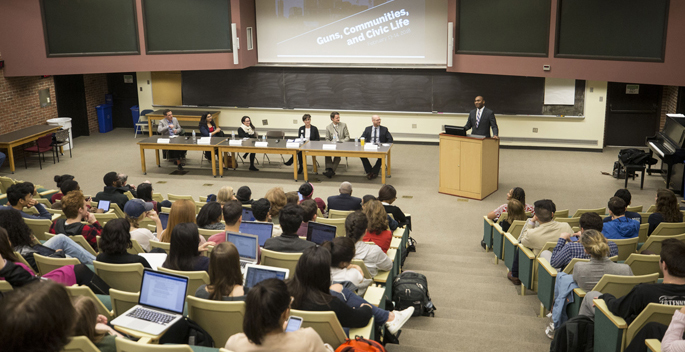
About the same time a Vanderbilt University School of Medicine panel discussion on gun violence prevention ended Feb. 14 in Light Hall, a heavily armed young man barged into his former high school in Parkland, Florida, and opened fire on students and teachers, killing 17 and injuring others.
The gunman, armed with a semiautomatic AR-15 rifle, was identified as Nikolas Cruz, a 19-year-old who had been expelled from the school, authorities said.
The United States has 4.5 percent of the population of the world, said Jonathan Metzl, MD, PhD, director of the Center for Medicine, Health and Society, kicking off the panel discussion. But Americans own 42 percent of all (650 million) civilian firearms in the world.
“With so much passion and tension and misinformation surrounding questions of guns and gun violence prevention in Tennessee we thought it was important as an academic community to step back and talk about the real evidence supporting gun violence prevention. We wanted to bring together experts to try to get a better sense of what is really going on and what everyday people can do about it,” Metzl said.
The Small Arms Survey, a Geneva-based research group, estimates national gun ownership rates range from a high of 90 firearms per every 100 people in the U.S., to one firearm or less for every 100 residents in South Korea and Ghana. Yemen, the country with the second highest number of firearms per 100 people — 55 — is one of the Arab world’s poorest countries and is in the midst of a civil war.
“Safety is a common goal, yet we remain unbelievably divided (about gun control),” said Metzl, Frederick B. Rentschler II Professor of Sociology and Medicine, Health and Society.
The panel, charged with addressing how to balance gun rights with public safety, the current state of firearm legislation, research and activism and other topics, consisted of Metzl, Stephan Heckers, MD, Ken MacLeish, PhD, and Purnima Unni, MPH, from Vanderbilt; Beth Roth, director of Safe Tennessee; Lee Harris, Tennessee State Senator from Memphis and Molly Pahn, of Boston University.
Heckers, William P. and Henry B. Test Professor of Schizophrenia Research and chair of the Department of Psychiatry and Behavioral Sciences, said that psychiatrists think about firearms every day.
“We need to ask every patient at every encounter about their access to firearms. They are a preventable cause of death,” he said, adding most gun deaths are from suicide not homicide.
Heckers, who also holds the Donald and Charlotte Test Clinical Directorship in Psychosis Programs, said there is great variability from one state to another about whether a person with a psychiatric diagnosis can own a firearm. “In some states, they aren’t eligible,” he said. He left the audience with a question: “Would you trust Abe Lincoln with a firearm? He had a serious mental disorder,” Heckers said. Lincoln is believed to have suffered from melancholy, which today is called clinical depression.
Roth oversees Safe Tennessee, a community of concerned citizens and academicians addressing some of the pressing issues regarding gun violence in Tennessee.
The organization supports the Second Amendment, but also advocates for common-sense measures that would lessen rates of gun injury and death in Tennessee without infringing on anyone’s rights. She spoke about the challenges of advocating for gun law reform in a red state, where 43 percent of Tennesseans are gun owners.
“There’s a knee-jerk reaction and people assume that we are trying to take their guns away. All we are talking about is storing them responsibly. Repealing the Second Amendment is pretty much never going to happen.”
Roth said that the primary reason that people give for having guns in their home is to protect their families, “and there are absolutely instances where people use guns to defend themselves, but you are statistically introducing risk into your home,” she said. “Someone is more likely to be shot within the home than to use the gun defending themselves.”
Roth ended with a slide showing a car going up a steep incline. “It’s an uphill battle, but at the end of the day I believe it’s an issue worth fighting for,” she said.
Unni, Pediatric Trauma Injury Prevention Program Manager at Monroe Carell Children’s Hospital at Vanderbilt, said Vanderbilt research shows that between 1998 and 2010 there were 188 gunshot wound patients 15 years old and younger treated at Vanderbilt’s Children’s Hospital. Forty-nine percent of those were instances where a juvenile shot themselves or a friend unintentionally; 45 percent were intentional shootings and 6 percent fell into the ‘other’ category. Of the 45 percent intentional, 36 percent were from an assault and 9 percent, from suicide or suicide attempts.
Looking at 80 firearms-related cases from January-December 2017, 12 patients were younger than 10 years; 15 were from 11-13 years old and 53 were 14-18 years old.
Unni said that Vanderbilt provides firearm safety education to those families about safe storage and using cable and trigger locks, and keeping ammunition separate from the guns.
“It’s an interesting conversation, a politically charged conversation, to have. There’s a lot of sensitivity about what you can and cannot say. You may be talking to someone with completely different views. Many want to keep their firearms loaded. But it’s time for us to come together as a group and take a stand.”















